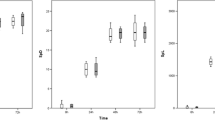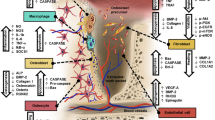Abstract
Objectives
Bisphosphonate-associated osteonecrosis of the jaw (BP-ONJ) is an adverse side effect of long-term bisphosphonate treatment. One theory of BP-ONJ etiology suggests a negative influence of these agents on angiogenesis and vascularization. This in vivo study analyzed the effects of bisphosphonates on angiogenesis in a 3D Matrigel assay.
Materials and methods
Matrigel plugs were implanted into fifty 6–8-week-old female nude mice. Ten animals each were treated either with clodronate, ibandronate, pamidronate, zoledronate, or carrier solution as controls. The microvessel density (MVD), microvessel area (MVA), and microvessel size (MVS) in Matrigel plugs were analyzed after 21 days of treatment by immunohistochemistry and exemplary 3D microvascular corrosion castings.
Results
All bisphosphonates induced a statistically significant decrease of MVD (p each <0.001), whereby the nitrogen-containing bisphosphonates (N-BPs) demonstrated a clearly stronger effect than non-nitrogen-containing bisphosphonates (NN-BP) clodronate (control 166, clodronate 99, ibandronate 48, pamidronate 47, zoledronate 35 microvessels/mm2). Referring to MVA, similar results could be detected. MVS was significantly increased especially by ibandronate (103 %) compared to control group (p < 0.001). Scanning electron microscope scans of the corrosion castings confirmed these results.
Conclusions
The stronger influence on MVD by N-BPs compared to the NN-BP clodronate may explain for the lack of BP-ONJ after treatment with NN-BPs.
Clinical relevance
Ibandronate induced a strong increase of MVS. In combination with the reduced MVD, this could result only in a fractional reduced perfusion which might be an explanation for the lower occurrence of BP-ONJ in patients receiving ibandronate compared to patients receiving pamidronate or zoledronate.






Similar content being viewed by others
References
Diel IJ, Bergner R, Grötz KA (2007) Adverse effects of bisphosphonates: current issues. J Support Oncol 5:475–82, Review
Marx RE (2003) Pamidronate (Aredia) and zoledronate (Zometa) induced avascular necrosis of jaws: a growing epidemic. J Oral Maxillofac Surg 61:1115–7
Walter C, Grötz KA, Kunkel M, Al-Nawas B (2007) Prevalence of bisphosphonate associated osteonecrosis of the jaw within the field of osteonecrosis. Support Care Cancer 15:197–202
Mashiba T, Hirano T, Turner CH, Forwood MR, Johnston CC, Burr DB (2000) Suppressed bone turnover by bisphosphonates increases microdamage accumulation and reduces some biomechanical properties in dog rib. J Bone Minor Res 15:613–20
Rogers MJ, Watts DJ, Russell RG (1997) Overview of bisphosphonates. Cancer 80:1652–60
Ohe JY, Kwon YD, Lee HW (2012) Bisphosphonates modulate the expression of OPG and M-CSF in hMSC-derived osteoblasts. Clin Oral Investig 16:1153–9
Marx RE, Sawatari Y, Fortin M, Broumand V (2005) Bisphosphonate-induced exposed bone (osteonecrosis/osteopetrosis) of the jaws: risk factors, recognition, prevention, and treatment. J Oral Maxillofac Surg 63:1567–75
Santini D, Vespasiani Gentilucci U, Vincenzi B, Picardi A, Vasaturo F, La Cesa A, Onori N, Scarpa S, Tonini G (2003) The antineoplastic role of bisphosphonates: from basic research to clinical evidence. Ann Oncol 14:1468–76, Review
Ziebart T, Koch F, Klein MO, Guth J, Adler J, Pabst A, Al-Nawas B, Walter C (2011) Geranylgeraniol—a new potential therapeutic approach to bisphosphonate associated osteonecrosis of the jaw. Oral Oncol 47:195–201
Landesberg R, Cozin M, Cremers S, Woo V, Kousteni S, Sinha S, Garrett-Sinha L, Raghavan S (2008) Inhibition of oral mucosal cell wound healing by bisphosphonates. J Oral Maxillofac Surg 66:839–47
Pabst AM, Ziebart T, Koch FP, Taylor KY, Al-Nawas B, Walter C (2012) The influence of bisphosphonates on viability, migration, and apoptosis of human oral keratinocytes—in vitro study. Clin Oral Investig 16:87–93
Taylor KH, Middlefell LS, Mizen KD (2010) Osteonecrosis of the jaws induced by anti-RANK ligand therapy. Br J Oral Maxillofac Surg 48:221–3
Van Poznak C (2010) Osteonecrosis of the jaw and bevacizumab therapy. Breast Cancer Res Treat 122:189–91
Koch FP, Walter C, Hansen T, Jäger E, Wagner W (2011) Osteonecrosis of the jaw related to sunitinib. Oral Maxillofac Surg 15:63–6
Walter C, Klein MO, Pabst A, Al-Nawas B, Duschner H, Ziebart T (2010) Influence of bisphosphonates on endothelial cells, fibroblasts, and osteogenic cells. Clin Oral Investig 14:35–41
Walter C, Pabst A, Ziebart T, Klein MO, Al-Nawas B (2011) Bisphosphonates affect migration ability and cell viability of HUVEC, fibroblasts and osteoblasts in-vitro. Oral Dis 17(2):194–9
Ziebart T, Pabst A, Klein MO, Kaemmerer P, Gauss L, Bruellmann D, Al-Nawas B, Walter C (2011) Bisphosphonates: restrictions for vasculogenesis and angiogenesis: inhibition of cell function of endothelial progenitor cells and mature endothelial cells in vitro. Clin Oral Investig 15:105–11
Allegra A, Oteri G, Nastro E, Alonci A, Bellomo G, Del Fabro V, Quartarone E, Alati C, De Ponte FS, Cicciù D, Musolino C (2007) Patients with bisphosphonates-associated osteonecrosis of the jaw have reduced circulating endothelial cells. Hematol Oncol 25:164–9
Santini D, Vincenzi B, Avvisati G et al (2002) Pamidronate induces modifications of circulating angiogenic factors in cancer patients. Clin Cancer Res 8:1080–4
Gerber HP, Ferrara N (2000) Angiogenesis and bone growth. Trends Cardiovasc Med 10:223–8, Review
Kleinman HK, McGarvey ML, Hassell JR, Star VL, Cannon FB, Laurie GW, Martin GR (1986) Basement membrane complexes with biological activity. Biochemistry 25:312–8
Ziebart T, Yoon CH, Trepels T, Wietelmann A, Braun T, Kiessling F, Stein S, Grez M, Ihling C, Muhly-Reinholz M, Carmona G, Urbich C, Zeiher AM, Dimmeler S (2008) Sustained persistence of transplanted proangiogenic cells contributes to neovascularization and cardiac function after ischemia. Circ Res 103:1327–34
Weibel ER, Kistler GS, Scherle WF (1966) Practical stereological methods for morphometric cytology. J Cell Biol 30:23–38
Ruggiero SL, Mehrotra B, Rosenberg TJ, Engroff SL (2004) Osteonecrosis of the jaws associated with use of bisphosphonates: a review of 63 cases. J Oral Maxillofac Surg 62:527–34
Marx RE, Cillo JE Jr, Ulloa JJ (2007) Oral bisphosphonate-induced osteonecrosis: risk factors, prediction of risk using serum CTX testing, prevention, and treatment. J Oral Maxillofac Surg 65:2397–410
Montazeri AH, Erskine JG, McQuaker IG (2007) Oral sodium clodronate induced osteonecrosis of the jaw in a patient with myeloma. Eur J Haematol 79:69–71
Aicher A, Kollet O, Heeschen C, Liebner S, Urbich C, Ihling C, Orlandi A, Lapidot T, Zeiher AM, Dimmeler S (2008) The Wnt antagonist Dickkopf-1 mobilizes vasculogenetic progenitor cells via activation of the bone marrow endosteal stem cell niche. Circ Res 103:796–803
Conway EM, Collen D, Carmeliet P (2001) Molecular mechanisms of blood vessel growth. Cardiovasc Res 49:507–21, Review
Burri PH, Djonov V (2002) Intussusceptive angiogenesis-the alternative to capillary sprouting. Mol Aspects Med 23:1–27, Review
Frith J, Mönkkönen J, Blackburn G, Russell R, Rogers M (1997) Clodronate and liposome-encapsulated clodronate are metabolized to a toxic ATP analog, adenosine 5′-(beta, gamma-dichloromethylene) triphosphate, by mammalian cells in vitro. J Bone Miner Res 12:1358–67
van Beek E, Cohen L, Leroy I, Ebetino F, Löwik C, Papapoulos S (2003) Differentiating the mechanisms of antiresorptive action of nitrogen containing bisphosphonates. Bone 33:805–11
Bifulco M (2005) Role of the isoprenoid pathway in ras transforming activity, cytoskeleton organization, cell proliferation and apoptosis. Life Sci 77:1740–9, Review
Crick DC, Andres DA, Waechter CJ (1997) Novel salvage pathway utilizing farnesol and geranylgeraniol for protein isoprenylation. Biochem Biophys Res Commun 237:483–7, Review
Christodoulou C, Pervena A, Klouvas G, Galani E, Falagas ME, Tsakalos G, Visvikis A, Nikolakopoulou A, Acholos V, Karapanagiotidis G, Batziou E, Skarlos DV (2009) Combination of bisphosphonates and antiangiogenic factors induces osteonecrosis of the jaw more frequently than bisphosphonates alone. Oncology 76:209–11
Acknowledgments
The authors acknowledge the technical skillful assistance of Kerstin Bahr.
Conflict of interest
The authors declare that there is no conflict of interests. Funding for this study was received by University Medical Center Mainz. Christian Walter has received speaker fees from Roche and funding from Novartis for a different study.
Author information
Authors and Affiliations
Corresponding author
Rights and permissions
About this article
Cite this article
Pabst, A.M., Ziebart, T., Ackermann, M. et al. Bisphosphonates’ antiangiogenic potency in the development of bisphosphonate-associated osteonecrosis of the jaws: influence on microvessel sprouting in an in vivo 3D Matrigel assay. Clin Oral Invest 18, 1015–1022 (2014). https://doi.org/10.1007/s00784-013-1060-x
Received:
Accepted:
Published:
Issue Date:
DOI: https://doi.org/10.1007/s00784-013-1060-x




